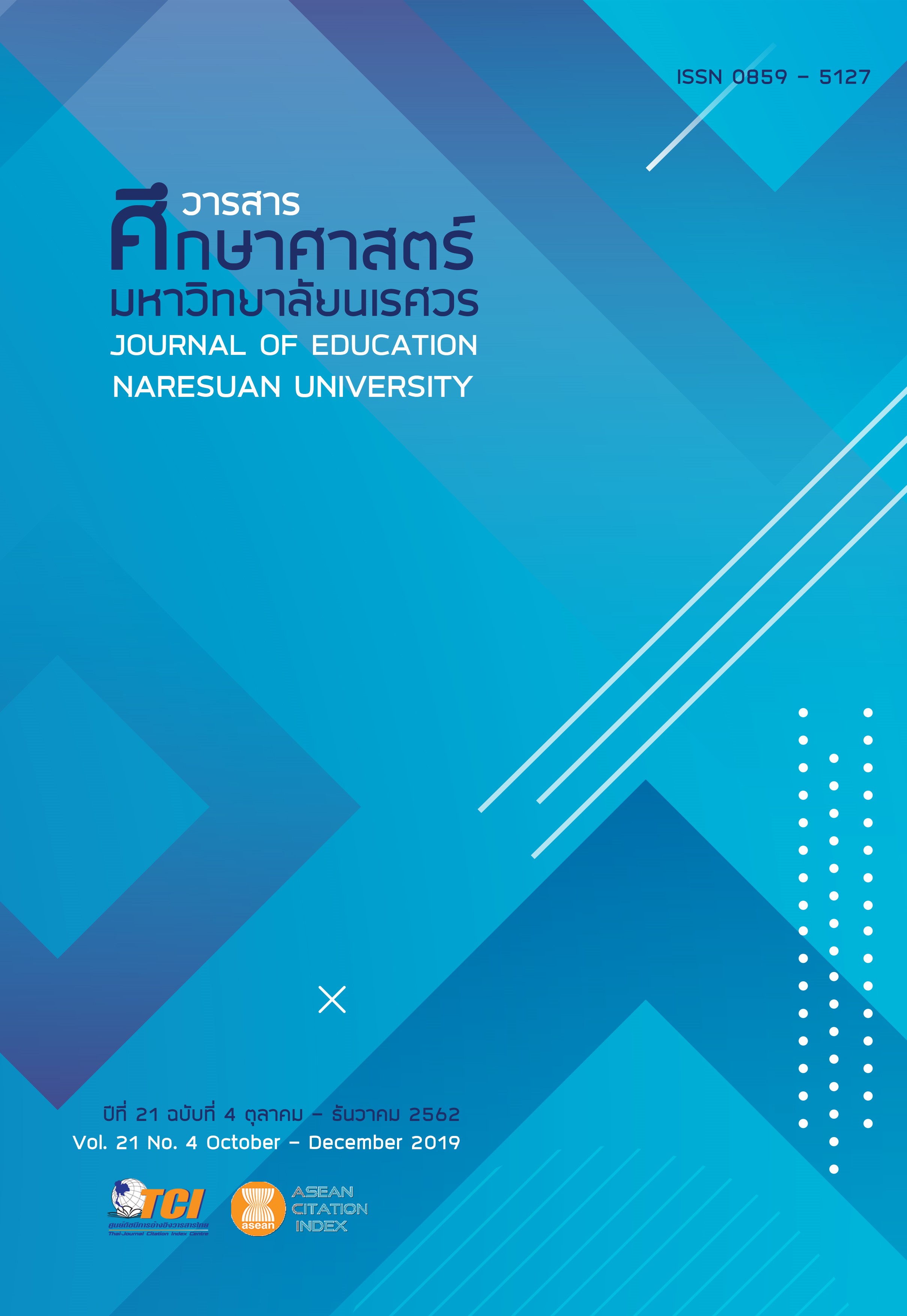การพัฒนารูปแบบการเรียนการสอนแบบผสมผสาน รายวิชาคอมพิวเตอร์สารสนเทศขั้นพื้นฐาน สำหรับนิสิตระดับปริญญาตรี (DEVELOPMENT OF BLENDED LEARNING MODEL IN INTRODUCTION TO COMPUTER INFORMATION SCIENCE COURSE FOR UNDERGRADUATE STUDENTS)
Main Article Content
บทคัดย่อ
การวิจัยครั้งนี้มีวัตถุประสงค์หลักเพื่อพัฒนารูปแบบการเรียนการสอนแบบผสมผสานรายวิชาคอมพิวเตอร์สารสนเทศขั้นพื้นฐาน สำหรับนิสิตระดับปริญญาตรี โดยมีวัตถุประสงค์เฉพาะ ดังนี้ 1) เพื่อศึกษาองค์ประกอบและสร้างรูปแบบการเรียนการสอนแบบผสมผสานรายวิชาคอมพิวเตอร์สารสนเทศขั้นพื้นฐาน สำหรับนิสิตระดับปริญญาตรี 2) เพื่อตรวจสอบคุณภาพและหาประสิทธิภาพของรูปแบบการเรียนการสอนแบบผสมผสานรายวิชาคอมพิวเตอร์สารสนเทศขั้นพื้นฐาน สำหรับนิสิตระดับปริญญาตรี 3) เพื่อเปรียบเทียบผลสัมฤทธิ์ทางการเรียนก่อนและหลังการเรียนด้วยการจัดการเรียนการสอนตามรูปแบบการเรียนการสอนแบบผสมผสาน รายวิชาคอมพิวเตอร์สารสนเทศขั้นพื้นฐานสำหรับนิสิตระดับปริญญาตรี และ 4) เพื่อศึกษาความพึงพอใจของนิสิตที่มีต่อรูปแบบการเรียนการสอนแบบผสมผสานรายวิชาคอมพิวเตอร์สารสนเทศขั้นพื้นฐานสำหรับนิสิตระดับปริญญาตรี ในการวิจัยครั้งนี้มีขั้นตอนดำเนินการวิจัย 7 ขั้นตอน ได้แก่ (1) ศึกษาองค์ความรู้หรือเนื้อหาสารที่เกี่ยวข้อง (2) ประเมินความต้องการ (3) พัฒนากรอบแนวคิด
(4) ถามความเห็นผู้ทรงคุณวุฒิ (5) ยกร่างรูปแบบ (6) ทดสอบร่างรูปแบบ และ (7) การปรับปรุงและเขียนรายงาน มีกลุ่มตัวอย่างเป็นนิสิตระดับปริญญาตรี มหาวิทยาลัยนเรศวร ที่ลงทะเบียนเรียนรายวิชา คอมพิวเตอร์สารสนเทศขั้นพื้นฐาน ในภาคเรียนที่ 2 ปีการศึกษา 2559 1 กลุ่ม จำนวน 100 คน โดยการสุ่มตัวอย่างแบบแบ่งกลุ่ม ชนิดขั้นตอนเดียว (one-stage cluster sampling) เครื่องมือที่ใช้ในการวิจัย ได้แก่ รูปแบบการเรียนการสอนแบบผสมผสานรายวิชาคอมพิวเตอร์สารสนเทศขั้นพื้นฐานสำหรับนิสิตระดับปริญญาตรี แบบประเมินผลสัมฤทธิ์ก่อนเรียนและหลังเรียน แบบประเมินความพึงพอใจ และได้วิเคราะห์ข้อมูลโดยใช้ ความถี่ร้อยละ ค่าเฉลี่ย ส่วนเบี่ยงเบนมาตรฐาน และสถิติ t-test for dependent samples ผลการวิจัย พบว่า
1. รูปแบบการเรียนการสอนแบบผสมผสานรายวิชาคอมพิวเตอร์สารสนเทศขั้นพื้นฐานสำหรับนิสิตระดับปริญญาตรี มี 4 องค์ประกอบหลัก องค์ประกอบที่ 1 ปัจจัยนำเข้า ประกอบด้วย ผู้สอน ผู้เรียน หลักสูตร สื่อการเรียนการสอน วิธีการจัดการเรียนการสอน และการประเมินผล องค์ประกอบที่ 2 กระบวนการ โดยมีการปฐมนิเทศในสัปดาห์แรก หลังจากนั้นแต่ละสัปดาห์จะมีขั้นตอนการเรียนการสอน ดังนี้ 1) กิจกรรมการเรียนรู้ด้วยตอนเองผ่านสื่อออนไลน์นอกชั้นเรียน และ 2) กิจกรรมการเรียนรู้ในชั้นเรียน มีกิจกรรมย่อยตามลำดับ ดังนี้ (1) ทดสอบระหว่างเรียน (2) ทบทวนความรู้ (3) กำหนดประเด็นปัญหา (4) กิจกรรมกลุ่มย่อย (5) การประเมินผล องค์ประกอบที่ 3 ผลลัพธ์ และองค์ประกอบที่ 4 ข้อมูลย้อนกลับ
2. การประเมินคุณภาพจากผู้ทรงคุณวุฒิ 7 คน มีค่าเฉลี่ยนอยู่ในระดับเหมาะสมมากที่สุด และค่าประสิทธิภาพของกระบวนการ/ค่าประสิทธิภาพของผลลัพธ์ (E1/E2) มีค่าเท่ากับ 81.50/83.66 ซึ่งสอดคล้องตามเกณฑ์ที่กำหนด (80/80)
3. นิสิตที่เรียนด้วยรูปแบบการเรียนการสอนแบบผสมผสานรายวิชาคอมพิวเตอร์สารสนเทศขั้นพื้นฐานสำหรับนิสิตระดับปริญญาตรี มีผลสัมฤทธิ์ทางการเรียนสูงกว่าก่อนเรียนอย่างมีนัยสำคัญทางสถิติที่ระดับ .01
4. นิสิตมีความพึงพอใจต่อการเรียนการสอนตามรูปแบบการเรียนการสอนแบบผสมผสานรายวิชาคอมพิวเตอร์สารสนเทศขั้นพื้นฐานสำหรับนิสิตระดับปริญญาตรี ในระดับมาก ( = 3.76, S.D. = 0.95)
DEVELOPMENT OF BLENDED LEARNING MODEL IN INTRODUCTION TO COMPUTER INFORMATION SCIENCE COURSE FOR UNDERGRADUATE STUDENTS
This dissertation aims to develop the Blended Learning model in Basic Computer Information Science course for undergraduate students. There are four specific aims: 1) To Study the Body of Content and develop the Blended Learning model in Basic Computer Information Science course for undergraduate students. 2) To evaluate the quality and the efficiency of the Blended Learning model in Basic Computer Information Science course for undergraduate students. 3) To Compare the Learning Achievements before and after using the Blended Learning model in Basic Computer Information Science course for undergraduate students. 4) To investigate students' satisfaction towards the Blended Learning model in Basic Computer Information Science course for undergraduate students. The research procedure comprised in 7 steps; (1) Study the Body of Content, (2) Assess needs for the innovative prototypes, (3) Develop Conceptual Framework, (4) Seek Experts’ Opinions, (5) Draft the Innovative Prototype, (6) Test the Prototype, and (7) Finalize the Prototype and Write Final Reports. The sample group consisted of 100 undergraduate students of Naresuan University, in the 2/2016 Semester, who enrolled in Basic Computer Information Science. Research instruments included the Blended Learning model in Basic Computer Information Science course for undergraduate students, pretest-posttest evaluation form of academic achievement, and satisfaction evaluation form. Frequency, percentage, mean, standard deviation, and t-test were statistical devices used for the data analysis. The results were as follows:
1. The developed model consists of four components: Component 1: Input, consists of Instructor, Learner, Curriculum, Learning media and Instructional Methods. Component 2: Process, consisted of 2 stages. Stage 1: preparation. Teacher introduce to the blended learning activities and demonstrations. Stage 2: Teaching and learning, consisted of 4 steps. Step 1: Self-student outside the classroom. Step 2: Inside the classroom activities. 2.1) formative assessment. 2.2) Lecture. 2.3) Problem identification for small group activities. 2.4) Small group activities. 2.5) Conclusion and Evaluation. Component 3: Output. And Component 4: Feedback. The research-based approach and development together with the experiment of learning and studying were applied in each stage. The experts agreed that the consisted of had the quality at a high level. The results of the pilot study indicated that the developed model had feasibility for the implementation and it could be used for developing
the students’ learning achievements.
2. The Efficiency of the developed model was 81.50/83. That was relevant with the 80/80 setting criteria.
3. Learning achievement of the students after learning using the developed model was high than before using statistical significant difference at .01 level.
4. The students' satisfaction of the learning using the developed model was at the high level ( = 3.76, S.D. = 0.95).
Article Details
เจ้าของบทความมิได้คัดลอก หรือละเมิดลิขสิทธิ์ของผู้ใด หากเกิดการละเมิดลิขสิทธิ์ ไม่ว่าวิธีใด หรือการฟ้องร้องไม่ว่ากรณีใด ๆ ที่อาจเกิดขึ้นได้ กองบรรณาธิการวารสารศึกษาศาสตร์ ไม่มีส่วนเกี่ยวข้องทั้งสิ้น ให้เป็นสิทธิ์ของเจ้าของบทความที่จะดำเนินการ
เอกสารอ้างอิง
2. Bonk, C., Olson, T., Wisher, R., & Orvis, K. (2005). Blended web learning: Advantages, disadvantages, issues and considerations. Retrieved May 10, 2015, from https://www.uwex.edu/disted/conference
3. Brahmawong, C. (2008). Research and development of educational innovation. Retrieved May 10, 2015, from https://www.educ.su.ac.th/2013/images/stories/210655_01.pdf. [in Thai]
4. Chaiyama, N. (2011). The development of blended learning model by applying information technology to develop higher order thinking skills for students in the Institute of Physical Education Phetchabun Campus (Doctoral dissertation). Bangkok: Khon Kaen University. [in Thai]
5. Chumchai, P. (2016). The effectiveness of occupational health teaching based on problems-based learning model on achievement outcome, problem solving skill, team work skill, and satisfaction of nursing student, Boromrajonani College of Nursing, Phra Putthabat. Journal of Nursing and Education, 9(4), 60-75. [in Thai]
6. Division of General Education. (2016). Course description: Introduction to computer information science. Retrieved June 20, 2016, from https://gened.nu.ac.th/a_menu1-4_1.php [in Thai]
7. Garnham, C., & Kaleta, R. (2002). Introduction to hybrid courses. Teaching with Technology Today, 8(6). Retrieved May 5, 2015, from https://www.uwsa.edu/ttt/articles/garnham.htm
8. Namoungon, S. (2016). The effects of flipped classroom with team based learning in the introduction to computer information science course for undergraduate students (Master thesis). Phitsanulok: Naresuan University. [in Thai]
9. Niemiec, M., et al. (2009). An administrator’s guide to the whys and hows of blended learning. Retrieved May 25, 2015, from https://sloanconsortium.org/publications/jaln_main?page=3
10. Paichamnan, A. (2013). A development of blended learning model in educational technology and innovation for graduate diploma teaching profession students in Yala Islamic University (Master thesis). Songkla: Prince of Songkla University. [in Thai]
11. Phakdeeteva, S. (2010). The development of the e-learning instructional design model for graduate program Sukhothai Thammathirat Open University (Doctoral dissertation). Bangkok: Silpakorn University. [in Thai]
12. Sankas, S. (2010). A development of content and activity blended learning model on computer programming (Doctoral dissertation). Bangkok: King Mongkut's University of Technology Thonburi. [in Thai]
13. Srisa-ard, B. (2002). Basic research (7th ed.). Bangkok: Suviriyasarn. [in Thai]
14. The Sloan Consortium. (2005). Growing by degrees online education in the United States. Retrieved May 28, 2015, from https://www.sloanc.org/resources /growing_by_degree.pdf


